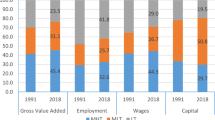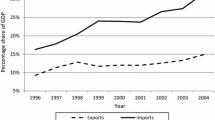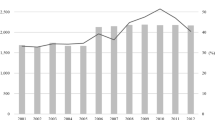Abstract
Controlling firms’ sales in the labour demand model, this paper investigates effects of trade and R&D via technical progress on labour demand in a dynamic framework, based on a panel of Swedish manufacturing firms for 1990s. The main results of this study indicate that employment elasticities with respect to different characteristics of firms (wages, total sales, exports and R&D efforts) and industrial import penetration could vary across respective skilled sectors. There is some indication to that import penetration from fourteen ‘old members’ of European Union could induce capital-saving technical progress and result in the rise in demand for labour for firms in medium-low skilled sector, whilst those from the ten ‘new members’ of European Union could induce x-efficiency and labour-saving technical progress for firms in low-skilled sector. Furthermore, the effects of R&D intensity on demand for labour are positive and significant for firms in medium-high-skilled and high-skilled sectors.
Similar content being viewed by others
Notes
The ten countries that joined the EU with effect from May 2004.
R&D expenditure are only available for firms with at least 50 employees in the manufacturing sector, which is reported in Financial Statistics (FS) but with zero values for more than 50% of the observations. Similarly, information about export and domestic sale are only available for the firms with at least 50 employees.
See Lundin (2004)
See, e.g. Nickell and Wadhwani (1991) and Revenga (1997) for detail discussions on insider and outsider wages. Nickell and Wadhwani (1991) argue that it is positive as the industrial wages are associated with firm wages. Then, when it is negative, it is consistent with the assumption of efficient wage models.
References
Abraham, F. and Brock, E., “Sectoral employment effects of trade and productivity in a small open economy,” Tijdschrift voor Economie en Management, vol. XLVII no. 2, pp. 167–204, 2002.
Andersson, L., Gustafsson, O., and Lundberg, L., “Structural change, competition, and job turnover in Swedish manufacturing, 1964–96,” Review of International Economics, vol. 8 no.3, pp. 566–582, 2000.
Arellano, M., and Bond, S., “Some tests of specification for panel data: Monte Carlo evidence and an application to employment equations,” Review of Economic Studies, vol. 58 no. 2, pp. 277–297, 1991.
Arellano, M. and Bover, O., “Another look at the instrumental variable estimation of error-components models,” Journal of Econometrics, vol. 68, pp. 29–51, 1995.
Baltagi, B.H., Econometric Analysis of Panel Data. Wiley: West Sussex, UK, 2001.
Blundell, R. and Bond, S., “Initial conditions and moment restrictions in dynamic panel data models,” Journal of Econometrics, vol. 87, pp. 115–143, 1998.
Brenton, P., “Rising trade and falling wages: A review of the theory and empirics,” in Brenton, P. and Pelkmans, J. (eds.), Global Trade and European Workers. Macmilian: Houndmills, UK, pp. 18–35, 1999.
Brenton, P. and Pelkmans, J., Global Trade and European Workers. Macmilian: Houndmills, UK, 1999.
European Commission, European Competitiveness Report-2000, Luxembourg, 2000.
Gaston, N. and Nelson, D., The Employment and Wage Effects of Immigration: Trade and Labour Economics Perspectives. Working Paper 2001/28, the Leverhulme Centre for Research on Globalisation and Economic Policy: Nottingham, 2001.
Greenaway, D., Hine, R.C., and Wright, P.W., “An empirical assessment of the impact of trade on employment in the United Kingdom,” European Journal of Political Economy, vol. 15 no. 3, pp. 485–500, 1999.
Hine, R.C. and Wright, P.W., “Trade with low wage economies, employment and productivity in UK manufacturing,” Economic Journal, vol. 108 no. 450, pp. 1500–1510, 1998.
Hsiao, C., Analysis of Panel Data, 2nd edition. Cambridge University Press: Cambridge, 2003.
Jansen, M., International Trade and the Position of European Low-skilled Labour. Staff Working Paper, ERAD-2000-01, WTO: Vienna, 2000.
Karlsson, M. (eds.), The Internationalization of Corporate R&D––Leveraging the Changing Geography of Sweden. A2006:007, Swedish Institute for Growth Policy Studies: Ostersund, 2006.
Landesmann, M., Trade Liberalization and Labour Markets: Perspective from OECD Economies. WIIW Working Papers, No. 20, Johannes Kepler University: Linz, 2001.
Lundin, N., “Has import disciplined Swedish manufacturing firms in the 1990s?” Journal of Industry, Competition and Trade, vol. 4 no. 2, pp. 109–133, 2004.
Milner, C. and Wright, P.W., “Modelling labour market adjustment to trade liberalisation in an industrialising economy,” Economic Journal, vol. 108 no. 447, pp. 509–528, 1998.
Morrison-Paul, C.J. and Siegel, D.S., “The impacts of technology, trade and outsourcing on employment and labour composition,” Scandinavian Journal of Economics, vol. 103 no. 2, pp. 241–264, 2001.
Neven, D. and Wyplosz, C., Relative Prices, Trade and Restructuring in European Industry. Discussion Paper, No. 1451, CEPR: London, 1996.
Nickell, S. and Wadhwani, S., “Employment determination in British industry: Investigations using micro-data,” Review of Economic Studies, vol. 58 no. 5, pp. 955–969, 1991.
OECD, OECD Economic Outlook No.79. OECD: Paris, 2006.
Peneder, M., “Industry classification: Aim, scope and techniques,” Journal of Industry, Competition and Trade, vol. 3 no. 1/2, pp. 109–129, 2003.
Piva, M. and Vivarelli, M., Innovation and Employment: Evidence from Italian Microdata. IZA Discussion Paper, No. 730, Institute for the Study of Labor: Bonn, 2003.
Revenga, A., “Employment and wage effects of trade liberalization: The case of Mexican manufacturing,” Journal of Labour Economics, vol. 15 no. 3, pp. S20–S43, 1997.
Rouvinen, P., “R&D-productivity dynamics: Causality, lags and ‘dry holes,’” Journal of Applied Economics, vol. V no. 1, pp. 123–156, 2002.
Slaughter, M.J. and Swagel, P., The Effect of Globalisation on Wages in the Advanced Economies. IMF Working Paper, No. 97/43, 1997(a).
Slaughter, M.J. and Swagel, P., Does Globalisation Lower Wages and Export Jobs? IMF Economic Issues 11, 1997(b).
van Reenen, J., “Employment and technical innovation: Evidence from U.K. manufacturing firms,” Journal of Labour Economics, vol. 15 no. 2, pp. 255–284, 1997.
Winchester, N., Greenaway, D., and Reed, G.V., “Skill classification and the effects of trade on wage inequality,” Review of World Economics, vol. 142 no. 2, pp. 287–306, 2006.
Windmeijer, F., A Finite Sample Correction for the Variance of Linear Two-step GMM Estimators. Working Paper 00/19, the Institute for Fiscal Studies (IFS): London, 2000.
Wood, A., North-South Trade, Employment and Inequality. Clarendon Press: Oxford, 1994.
Young, A., “Learning by doing and the dynamic effects of international trade,” Quarterly Journal of Economics, vol. 106 no. 2, pp. 369–405, 1991.
Acknowledgements
Author is grateful for Lars Lundberg, Eddy Szirmai, Fredrik Heyman, Lars Hultkrantz, Sune Karlsson, Katariina Hakkala and anonymous referees for their valuable suggestions and comments. Author acknowledges gratefully the research scholarships facilitated by the Swedish Foundation for International Cooperation in Research and Higher Education (STINT) and the Bank of Sweden Tercentenary Foundation (RJ) through their joint establishment of Swedish School of Advanced Asia Pacific Studies (SSAAPS).
Author information
Authors and Affiliations
Corresponding author
Appendices
Appendix A Trading partners
Appendix B Descriptions on variables
Appendix C Empirical statistics and regression results
Rights and permissions
About this article
Cite this article
Yun, L. Technical Progress and Labour Demand in Swedish Manufacturing Firms. J Ind Compet Trade 8, 147–167 (2008). https://doi.org/10.1007/s10842-007-0009-7
Received:
Revised:
Accepted:
Published:
Issue Date:
DOI: https://doi.org/10.1007/s10842-007-0009-7




